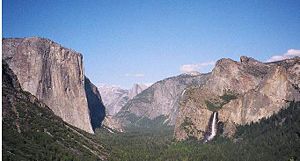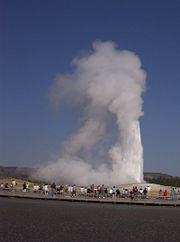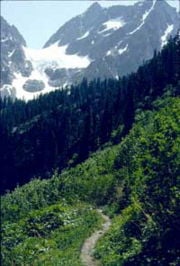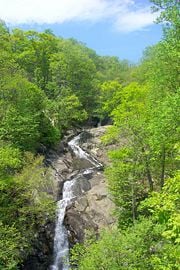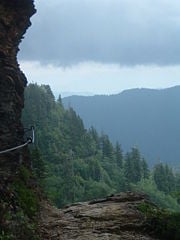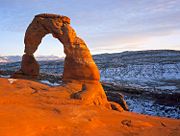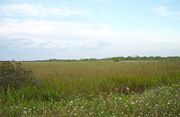Difference between revisions of "National Park" - New World Encyclopedia
Mary Anglin (talk | contribs) (import, credit & claim) |
Mary Anglin (talk | contribs) |
||
| Line 36: | Line 36: | ||
Most national parks have a dual role as offering a refuge for wildlife and as serving as popular tourist areas. Managing the potential for conflict between these two roles can become problematic, particularly as tourists often generate revenue for the parks which, in turn, are spent on conservation projects. Parks also serve as reserves for substantial natural resources, such as [[timber]], [[mineral]]s and other valuable commodities. The balance of the demand for extraction of these resources, against the damage this might cause, is often a very important challenge in national park management. National parks have been subject to [[illegal logging]] and other exploitation, sometimes because of [[political corruption]]. This threatens the integrity of many valuable [[habitat (ecology)|habitats]]. | Most national parks have a dual role as offering a refuge for wildlife and as serving as popular tourist areas. Managing the potential for conflict between these two roles can become problematic, particularly as tourists often generate revenue for the parks which, in turn, are spent on conservation projects. Parks also serve as reserves for substantial natural resources, such as [[timber]], [[mineral]]s and other valuable commodities. The balance of the demand for extraction of these resources, against the damage this might cause, is often a very important challenge in national park management. National parks have been subject to [[illegal logging]] and other exploitation, sometimes because of [[political corruption]]. This threatens the integrity of many valuable [[habitat (ecology)|habitats]]. | ||
| + | |||
| + | ==U.S. National Park System== | ||
| + | {| style="text-align:center" align="right" | ||
| + | {{National parks of the United States map}} | ||
| + | |} | ||
| + | |||
| + | The '''National Park System''' of the [[United States]] is the collection of physical properties owned or administered by the [[National Park Service]]. This includes all areas designated [[National Park]]s and most [[U.S. National Monument|National Monuments]], as well as several other types of [[protected areas of the United States]]. | ||
| + | |||
| + | As of 2007, there are {{National Park Units}} "[[List of the United States National Park System official units|units]]" of the National Park System. However, this number is somewhat misleading. For example: [[Denali National Park and Preserve]] is counted as two units, whereas [[Fort Moultrie National Monument]] is not counted as a unit because it is considered a feature of [[Fort Sumter National Monument]]. | ||
| + | |||
| + | In addition to areas of the National Park System, the National Park Service also provides technical and financial assistance to several "affiliated areas" authorized by Congress. Affiliated areas are marked on the lists below.</onlyinclude> | ||
| + | |||
| + | The [[National Register of Historic Places]] is administered by the Park Service (with nearly 79,000 entries) and automatically includes all National Park System areas designated due to their historic significance. This includes all National Historical Parks/Historic Sites, National Battlefields/Military Parks, National Memorials, and some National Monuments. | ||
| + | |||
| + | [[Delaware]] is the only state without a unit of the park system. Units are also found in [[Washington, D.C.]], [[Guam]], [[American Samoa]], the [[U.S. Virgin Islands]], and [[Puerto Rico]]. | ||
| + | |||
| + | Nearly all units managed by the National Park Service participate in the [[National Park Passport Stamps]] program. | ||
| + | |||
| + | === National Parks Listing === | ||
| + | [[Image:Old faithful geyser.jpg|thumb|right|180px|Yellowstone National Park, Wyoming]] | ||
| + | [[Image:Cascade Pass trail-200px.jpg|thumb|right|180px|North Cascades National Park, Washington]] | ||
| + | [[Image:Whiteoak Canyon Shenandoah NP Virginia.JPG|thumb|180px|right|Shenandoah National Park, Virginia]] | ||
| + | [[Image:Alum Cave Bluffs Trail.jpg|right|thumb|180px|Great Smoky Mountains National Park|Great Smoky Mountains National Park, North Carolina / Tennessee]] | ||
| + | [[Image:Delicatearch.jpg|right|thumb|180px|Arches National Park, Utah]] | ||
| + | [[Image:Anhingatrail.jpg|right|thumb|180px|Everglades National Park, Florida]] | ||
| + | As of 2006, there are 58 officially-designated National Parks in the United States and its dependent areas. | ||
| + | {| class="sortable wikitable" width="70%" | ||
| + | |- | ||
| + | !width="50%"|Name | ||
| + | !width="25%"|Location | ||
| + | |- | ||
| + | | [[Acadia National Park]] | ||
| + | | [[Maine]] | ||
| + | <!--| 1916 | ||
| + | | align="right" | 46,854—> | ||
| + | |- | ||
| + | | [[National Park of American Samoa]] | ||
| + | | [[American Samoa]] | ||
| + | <!--| 1988 | ||
| + | | align="right" | 9,000—> | ||
| + | |- | ||
| + | | [[Arches National Park]] | ||
| + | | [[Utah]] | ||
| + | <!--| 1971 | ||
| + | | align="right" | 76,519—> | ||
| + | |- | ||
| + | | [[Badlands National Park]] | ||
| + | | [[South Dakota]] | ||
| + | <!--| 1978 | ||
| + | | align="right" | 242,756—> | ||
| + | |- | ||
| + | | [[Big Bend National Park]] | ||
| + | | [[Texas]] | ||
| + | <!--| 1944 | ||
| + | | align="right" | 801,163—><includeonly> | ||
| + | |}</includeonly></onlyinclude> | ||
| + | |- | ||
| + | | [[Biscayne National Park]] | ||
| + | | [[Florida]] | ||
| + | <!--| 1980 | ||
| + | | align="right" | 172,924—> | ||
| + | |- | ||
| + | | [[Black Canyon of the Gunnison National Park]] | ||
| + | | [[Colorado]] | ||
| + | <!--| 1999 | ||
| + | | align="right" | 32,950—> | ||
| + | |- | ||
| + | | [[Bryce Canyon National Park]] | ||
| + | | [[Utah]] | ||
| + | <!--| 1928 | ||
| + | | align="right" | 35,835—> | ||
| + | |- | ||
| + | | [[Canyonlands National Park]] | ||
| + | | [[Utah]] | ||
| + | <!--| 1964 | ||
| + | | align="right" | 337,598—> | ||
| + | |- | ||
| + | | [[Capitol Reef National Park]] | ||
| + | | [[Utah]] | ||
| + | <!--| 1971 | ||
| + | | align="right" | 241,904—> | ||
| + | |- | ||
| + | | [[Carlsbad Caverns National Park]] | ||
| + | | [[New Mexico]] | ||
| + | <!--| 1930 | ||
| + | | align="right" | 46,766—> | ||
| + | |- | ||
| + | | [[Channel Islands National Park]] | ||
| + | | [[California]] | ||
| + | <!--| 1980 | ||
| + | | align="right" | 249,561—> | ||
| + | |- | ||
| + | | [[Congaree National Park]] | ||
| + | | [[South Carolina]] | ||
| + | <!--| 2003 | ||
| + | | align="right" | 22,200—> | ||
| + | |- | ||
| + | | [[Crater Lake National Park]] | ||
| + | | [[Oregon]] | ||
| + | <!--| 1902 | ||
| + | | align="right" | 183,224—> | ||
| + | |- | ||
| + | | [[Cuyahoga Valley National Park]] | ||
| + | | [[Ohio]] | ||
| + | <!--| 2000 | ||
| + | | align="right" | 32,861—> | ||
| + | |- | ||
| + | | [[Death Valley National Park]] | ||
| + | | [[California]], [[Nevada]] | ||
| + | <!--| 1994 | ||
| + | | align="right" |3,372,402—> | ||
| + | |- | ||
| + | | [[Denali National Park and Preserve]] | ||
| + | | [[Alaska]] | ||
| + | <!--| 1971 | ||
| + | | align="right" | 6,075,030—> | ||
| + | |- | ||
| + | | [[Dry Tortugas National Park]] | ||
| + | | [[Florida]] | ||
| + | <!--| 1992 | ||
| + | | align="right" | 64,701—> | ||
| + | |- | ||
| + | | [[Everglades National Park]] | ||
| + | | [[Florida]] | ||
| + | <!--| 1947 | ||
| + | | align="right" | 1,508,538—> | ||
| + | |- | ||
| + | | [[Gates of the Arctic National Park and Preserve]] | ||
| + | | [[Alaska]] | ||
| + | <!--| 1980 | ||
| + | | align="right" | 8,472,506—> | ||
| + | |- | ||
| + | | [[Glacier National Park (U.S.)|Glacier National Park]] (part of [[Waterton-Glacier International Peace Park]]) | ||
| + | | [[Montana]]/[[Alberta]] | ||
| + | <!--| 1910 | ||
| + | | align="right" | 1,013,572—> | ||
| + | |- | ||
| + | | [[Glacier Bay National Park and Preserve]] | ||
| + | | [[Alaska]] | ||
| + | <!--| 1980 | ||
| + | | align="right" | 3,283,246—> | ||
| + | |- | ||
| + | | [[Grand Canyon National Park]] | ||
| + | | [[Arizona]] | ||
| + | <!--| 1919 | ||
| + | | align="right" | 1,217,403—> | ||
| + | |- | ||
| + | | [[Grand Teton National Park]] | ||
| + | | [[Wyoming]] | ||
| + | <!--| 1929 | ||
| + | | align="right" | 309,995—> | ||
| + | |- | ||
| + | | [[Great Basin National Park]] | ||
| + | | [[Nevada]] | ||
| + | <!--| 1986 | ||
| + | | align="right" | 77,180—> | ||
| + | |- | ||
| + | | [[Great Sand Dunes National Park and Preserve]] | ||
| + | | [[Colorado]] | ||
| + | <!--| 2004 | ||
| + | | align="right" | 42,000—> | ||
| + | |- | ||
| + | | [[Great Smoky Mountains National Park]] | ||
| + | | [[North Carolina]], [[Tennessee]] | ||
| + | <!--| 1934 | ||
| + | | align="right" | 521,776—> | ||
| + | |- | ||
| + | | [[Guadalupe Mountains National Park]] | ||
| + | | [[Texas]] | ||
| + | <!--| 1966 | ||
| + | | align="right" | 86,416—> | ||
| + | |- | ||
| + | | [[Haleakala National Park]] | ||
| + | | [[Hawaii]] | ||
| + | <!--| 1916 | ||
| + | | align="right" | 29,094—> | ||
| + | |- | ||
| + | | [[Hawaii Volcanoes National Park]] | ||
| + | | [[Hawaii]] | ||
| + | <!--| 1916 | ||
| + | | align="right" | 323,431—> | ||
| + | |- | ||
| + | | [[Hot Springs National Park]] | ||
| + | | [[Arkansas]] | ||
| + | <!--| 1921 | ||
| + | | align="right" | 5,550—> | ||
| + | |- | ||
| + | | [[Isle Royale National Park]] | ||
| + | | [[Michigan]] | ||
| + | <!--| 1940 | ||
| + | | align="right" | 571,790—> | ||
| + | |- | ||
| + | | [[Joshua Tree National Park]] | ||
| + | | [[California]] | ||
| + | <!--| 1994 | ||
| + | | align="right" | 789,866—> | ||
| + | |- | ||
| + | | [[Katmai National Park and Preserve]] | ||
| + | | [[Alaska]] | ||
| + | <!--| 1980 | ||
| + | | align="right" | 4,093,229—> | ||
| + | |- | ||
| + | | [[Kenai Fjords National Park]] | ||
| + | | [[Alaska]] | ||
| + | <!--| 1980 | ||
| + | | align="right" | 669,983—> | ||
| + | |- | ||
| + | | [[Kings Canyon National Park]] | ||
| + | | [[California]] | ||
| + | <!--| 1940 | ||
| + | | align="right" | 865,952—> | ||
| + | |- | ||
| + | | [[Kobuk Valley National Park]] | ||
| + | | [[Alaska]] | ||
| + | <!--| 1980 | ||
| + | | align="right" | 1,750,717—> | ||
| + | |- | ||
| + | | [[Lake Clark National Park and Preserve]] | ||
| + | | [[Alaska]] | ||
| + | <!--| 1980 | ||
| + | | align="right" | 4,030,025—> | ||
| + | |- | ||
| + | | [[Lassen Volcanic National Park]] | ||
| + | | [[California]] | ||
| + | <!--| 1914 | ||
| + | | align="right" | 106,372—> | ||
| + | |- | ||
| + | | [[Mammoth Cave National Park]] | ||
| + | | [[Kentucky]] | ||
| + | <!--| 1941 | ||
| + | | align="right" | 52,830—> | ||
| + | |- | ||
| + | | [[Mesa Verde National Park]] | ||
| + | | [[Colorado]] | ||
| + | <!--| 1906 | ||
| + | | align="right" | 52,122—> | ||
| + | |- | ||
| + | | [[Mount Rainier National Park]] | ||
| + | | [[Washington]] | ||
| + | <!--| 1899 | ||
| + | | align="right" | 235,625—> | ||
| + | |- | ||
| + | | [[North Cascades National Park]] | ||
| + | | [[Washington]] | ||
| + | <!--| 1968 | ||
| + | | align="right" | 504,781—> | ||
| + | |- | ||
| + | | [[Olympic National Park]] | ||
| + | | [[Washington]] | ||
| + | <!--| 1938 | ||
| + | | align="right" | 922,651—> | ||
| + | |- | ||
| + | | [[Petrified Forest National Park]] | ||
| + | | [[Arizona]] | ||
| + | <!--| 1962 | ||
| + | | align="right" | 93,533—> | ||
| + | |- | ||
| + | | [[Redwood National and State Parks]] | ||
| + | | [[California]] | ||
| + | <!--| 1968 | ||
| + | | align="right" | 112,512—> | ||
| + | |- | ||
| + | | [[Rocky Mountain National Park]] | ||
| + | | [[Colorado]] | ||
| + | <!--| 1915 | ||
| + | | align="right" | 265,828—> | ||
| + | |- | ||
| + | | [[Saguaro National Park]] | ||
| + | | [[Arizona]] | ||
| + | <!--| 1994 | ||
| + | | align="right" | 91,440—> | ||
| + | |- | ||
| + | | [[Sequoia National Park]] | ||
| + | | [[California]] | ||
| + | <!--| 1890 | ||
| + | | align="right" | 865,952—> | ||
| + | |- | ||
| + | | [[Shenandoah National Park]] | ||
| + | | [[Virginia]] | ||
| + | <!--| 1935 | ||
| + | | align="right" | 199,045—> | ||
| + | |- | ||
| + | | [[Theodore Roosevelt National Park]] | ||
| + | | [[North Dakota]] | ||
| + | <!--| 1978 | ||
| + | | align="right" |70,448—> | ||
| + | |- | ||
| + | | [[Virgin Islands National Park]] | ||
| + | | [[U.S. Virgin Islands]] | ||
| + | <!--| 1956 | ||
| + | | align="right" | 14,689—> | ||
| + | |- | ||
| + | | [[Voyageurs National Park]] | ||
| + | | [[Minnesota]] | ||
| + | <!--| 1975 | ||
| + | | align="right" | 218,200—> | ||
| + | |- | ||
| + | | [[Wind Cave National Park]] | ||
| + | | [[South Dakota]] | ||
| + | <!--| 1903 | ||
| + | | align="right" | 28,295—> | ||
| + | |- | ||
| + | | [[Wrangell-St. Elias National Park and Preserve]] | ||
| + | | [[Alaska]] | ||
| + | <!--| 1980 | ||
| + | | align="right" | 13,175,901—> | ||
| + | |- | ||
| + | | [[Yellowstone National Park]] | ||
| + | | [[Idaho]], [[Montana]], [[Wyoming]] | ||
| + | <!--| 1872 | ||
| + | | align="right" | 2,219,791—> | ||
| + | |- | ||
| + | | [[Yosemite National Park]] | ||
| + | | [[California]] | ||
| + | <!--| 1890 | ||
| + | | align="right" | 761,266—> | ||
| + | |- | ||
| + | | [[Zion National Park]] | ||
| + | | [[Utah]] | ||
| + | <!--| 1919 | ||
| + | | align="right" | 146,598—> | ||
| + | |} | ||
| + | |||
| + | ===U.S. National Monument=== | ||
| + | [[Image:Devils Tower.jpg|thumb|220px|[[Devils Tower National Monument]]]] | ||
| + | [[Image:Keet Seel closeup.jpg|thumb|220px|[[Navajo National Monument]]]] | ||
| + | |||
| + | A '''National Monument''' in the [[United States]] is a [[protected area]] that is similar to a [[national park]] (specifically a [[U.S. National Park]]) except that the [[President of the United States]] can quickly declare an area of the United States to be a [[national monument]] without [[United States Congress|Congress]]ional approval. National monuments receive less funding and afford fewer protections to wildlife than national parks. | ||
| + | |||
| + | Another difference between a national monument and national park is the amount of diversity in what is being protected; national monuments aim to preserve at least one unique resource but do not have the amount of diversity of a national park (which are supposed to protect a host of unique features). However areas within and extending beyond, national parks, monuments or even [[National Forest|national forests]] can be part of [[U.S. Wilderness Area|wilderness area]]s, which have an even greater degree of protection than a national park would alone, although wilderness areas managed by the [[United States Forest Service|USDA Forest Service]] and U.S. [[Bureau of Land Management]] often allow [[hunting]]. | ||
| + | |||
| + | National monuments are managed by the [[National Park Service]], USDA Forest Service, [[United States Fish and Wildlife Service]] or by the Bureau of Land Management. | ||
| + | |||
| + | The power to grant national monuments came from President [[Theodore Roosevelt]], who declared [[Devils Tower]] in [[Wyoming]] as the very first national monument. He thought Congress was moving too slowly and it would be ruined by the time they got around to making it a national park. | ||
==Other sites designated for preservation== | ==Other sites designated for preservation== | ||
| Line 73: | Line 407: | ||
[[Category:Parks and Landmarks]] | [[Category:Parks and Landmarks]] | ||
| − | {{credit|173886452}} | + | {{credit|National_Park|173886452|U.S._National_Monument|173765453|List_of_areas_in_the_United_States_National_Park_System|174255589}} |
Revision as of 22:58, 3 December 2007

A national park is a reserve of land, usually, but not always (see National Parks of England and Wales), declared and owned by a national government, protected from most human development and pollution. National parks are a protected area of IUCN category II. The largest national park in the world is the Northeast Greenland National Park, which was established in 1974.
History
Prologue
In 1810, the English poet William Wordsworth described the Lake District as a "sort of national property in which every man has a right and interest who has an eye to perceive and a heart to enjoy". The painter George Catlin, in his travels though the American West, wrote in 1832 that the Native Americans in the United States might be preserved: by some great protecting policy of government . . . in a magnificent park . . . A nation's park, containing man and beast, in all the wild and freshness of their nature's beauty! Similar ideas were expressed in other countries—in Sweden, for instance, the Finnish-born Baron Adolf Erik Nordenskiöld made such a proposition in 1880. The Scottish-American naturalist John Muir was inspirational in the foundation of national parks, anticipating many ideas of conservationism, environmentalism, and the animal rights movement.
Establishment
The first effort by any government to set aside such protected lands was in the United States, on April 20, 1832, when President Andrew Jackson signed legislation to set aside four sections of land around what is now Hot Springs, Arkansas to protect the natural, thermal springs and adjoining mountainsides for the future disposal of the US government. It was known as the Hot Springs Reservation. However no legal authority was established and federal control of the area was not clearly established until 1877.
The next effort by any government to set aside such protected lands was in the United States, when President Abraham Lincoln signed an Act of Congress on June 30, 1864, ceding the Yosemite Valley and the Mariposa Grove of Giant Sequoias (later becoming the Yosemite National Park) to the state of California:
- [T]he said State shall accept this grant upon the express conditions that the premises shall be held for public use, resort, and recreation; shall be inalienable for all time.
In 1872, Yellowstone National Park was established as the world's first truly national park. When news of the natural wonders of the Yellowstone were first published, the land was part of a territory. Unlike Yosemite, there was no state government that could assume stewardship of the land, so the Federal Government took on direct responsibility for the park, a process formally completed in October 1, 1890. It took the combined effort and interest of conservationists, politicians and especially businesses—namely, the Northern Pacific Railroad, whose route through Montana would greatly benefit by the creation of this new tourist attraction—to ensure the passage of the legislation by the United States Congress to create Yellowstone National Park.
The 'dean of western writers,' American Pulitzer prize-winning author Wallace Stegner, has written that national parks are 'America's best idea,'—a departure from the royal preserves that Old World sovereigns enjoyed for themselves—inherently democratic, open to all, "they reflect us at our best, not our worst."[1] Even with the creation of Yellowstone, Yosemite, and nearly 37 other national parks and monuments, another 44 years passed before an agency was created in the United States to administer these units in a comprehensive way - the U.S. National Park Service (NPS). Businessman Stephen Mather pushed hardest for the creation of the NPS, writing then-Secretary of the Interior Franklin Knight Lane about such a need. Lane invited Mather to come to Washington, DC to work with him to draft and see passage of the NPS Organic Act, which was approved by Congress and signed into law on August 25, 1916.
The number of areas now managed by the National Park Service in the United States consists of 391 different sites, of which only 58 carry the designation of National Park.
Following the idea established in Yellowstone there soon followed parks in other nations. In Australia, the Royal National Park was established just south of Sydney in 1879. In Canada, Banff National Park (then known as Rocky Mountain National Park) became its first national park in 1885. New Zealand had its first national park in 1887. In Europe the first national parks were a set of nine parks in Sweden in 1909. Europe has 370 national parks at the moment.[2] In 1926, the British administration in South Africa designated Kruger National Park as the nation's first national park.
After World War II, national parks were founded all over the world. The Vanoise National Park in the Alps was the first French national park, created in 1963 after public mobilization against a touristic project.
Features preserved
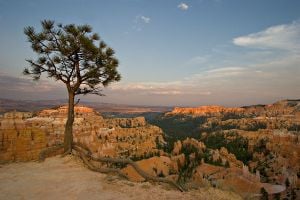
National parks are usually located in places which have been largely undeveloped, and often feature areas with exceptional native animals, plants and ecosystems (particularly endangered examples of such), biodiversity, or unusual geological features. Occasionally, national parks are declared in developed areas with the goal of returning the area to resemble its original state as closely as possible.
In some countries, such as England and Wales, areas designated as a national park are not wilderness, nor owned by the government, and can include substantial settlements and land uses which are often integral parts of the landscape. Scotland's first National Park, The Loch Lomond and The Trossachs National Park, was established in July 2002 while the Cairngorms National Park was established in March 2003.
Park mandates
Most national parks have a dual role as offering a refuge for wildlife and as serving as popular tourist areas. Managing the potential for conflict between these two roles can become problematic, particularly as tourists often generate revenue for the parks which, in turn, are spent on conservation projects. Parks also serve as reserves for substantial natural resources, such as timber, minerals and other valuable commodities. The balance of the demand for extraction of these resources, against the damage this might cause, is often a very important challenge in national park management. National parks have been subject to illegal logging and other exploitation, sometimes because of political corruption. This threatens the integrity of many valuable habitats.
U.S. National Park System
The National Park System of the United States is the collection of physical properties owned or administered by the National Park Service. This includes all areas designated National Parks and most National Monuments, as well as several other types of protected areas of the United States.
As of 2007, there are 391 "units" of the National Park System. However, this number is somewhat misleading. For example: Denali National Park and Preserve is counted as two units, whereas Fort Moultrie National Monument is not counted as a unit because it is considered a feature of Fort Sumter National Monument.
In addition to areas of the National Park System, the National Park Service also provides technical and financial assistance to several "affiliated areas" authorized by Congress. Affiliated areas are marked on the lists below.
The National Register of Historic Places is administered by the Park Service (with nearly 79,000 entries) and automatically includes all National Park System areas designated due to their historic significance. This includes all National Historical Parks/Historic Sites, National Battlefields/Military Parks, National Memorials, and some National Monuments.
Delaware is the only state without a unit of the park system. Units are also found in Washington, D.C., Guam, American Samoa, the U.S. Virgin Islands, and Puerto Rico.
Nearly all units managed by the National Park Service participate in the National Park Passport Stamps program.
National Parks Listing
As of 2006, there are 58 officially-designated National Parks in the United States and its dependent areas.
U.S. National Monument
A National Monument in the United States is a protected area that is similar to a national park (specifically a U.S. National Park) except that the President of the United States can quickly declare an area of the United States to be a national monument without Congressional approval. National monuments receive less funding and afford fewer protections to wildlife than national parks.
Another difference between a national monument and national park is the amount of diversity in what is being protected; national monuments aim to preserve at least one unique resource but do not have the amount of diversity of a national park (which are supposed to protect a host of unique features). However areas within and extending beyond, national parks, monuments or even national forests can be part of wilderness areas, which have an even greater degree of protection than a national park would alone, although wilderness areas managed by the USDA Forest Service and U.S. Bureau of Land Management often allow hunting.
National monuments are managed by the National Park Service, USDA Forest Service, United States Fish and Wildlife Service or by the Bureau of Land Management.
The power to grant national monuments came from President Theodore Roosevelt, who declared Devils Tower in Wyoming as the very first national monument. He thought Congress was moving too slowly and it would be ruined by the time they got around to making it a national park.
Other sites designated for preservation
Some countries also designate sites of special cultural, scientific or historical importance as national parks, or as special entities within their national park systems. Other countries use a different scheme for historical site preservation. Some of these sites, if they meet the criteria required, are awarded the title World Heritage Site by the UNESCO.
In many countries, local governmental bodies may be responsible for the maintenance of park systems. Some of these are also called national parks.
See also
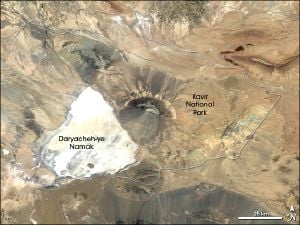
- List of national parks (arranged in lists by country)
- List of American National Parks
- National monument
- Conservation movement
- Conservation
- Federal lands
- International Network of Geoparks
- International Park
- National Forest
- Sustainable development
- National parks of England and Wales
- United Nations Environment Programme
- Fossil Park
External links
- National Park
- UNESCO — Man and the Biosphere Programme (Biosphere Reserves)
- World Heritage Sites
- UN Protected Areas database
- EUROPARC Federation — Europe's protected areas
- South Korea- Korea National Park Service
- European National Parks Centre (ENPC)
- TeddyRoosevelt.com: "The National Parks President"
Credits
New World Encyclopedia writers and editors rewrote and completed the Wikipedia article in accordance with New World Encyclopedia standards. This article abides by terms of the Creative Commons CC-by-sa 3.0 License (CC-by-sa), which may be used and disseminated with proper attribution. Credit is due under the terms of this license that can reference both the New World Encyclopedia contributors and the selfless volunteer contributors of the Wikimedia Foundation. To cite this article click here for a list of acceptable citing formats.The history of earlier contributions by wikipedians is accessible to researchers here:
- National_Park history
- U.S._National_Monument history
- List_of_areas_in_the_United_States_National_Park_System history
The history of this article since it was imported to New World Encyclopedia:
Note: Some restrictions may apply to use of individual images which are separately licensed.
